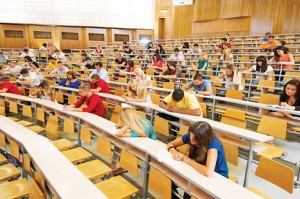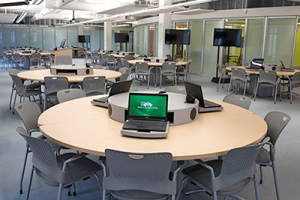Universities across the country, including here at BGSU, are increasingly hosting courses in active learning classrooms. As of 2018, these rooms are gaining traction nationally due to their immense resources, mobility, student engagement and positive reviews by professors. Within the last few semesters, the Department of History has taught multiple courses in these classrooms. Today, we are going to discuss our thoughts from the experiences.
But first, what exactly is an active learning classroom? In short, an active learning classroom is one that encourages active participation from the students and professor. Rather than having the professor’s desk up front and the students in rows facing towards the professor, desks in an active learning classroom are arranged adjacently and “scattered” with the teacher being able to walk around the room freely. There is no front of the room per say or one central location that students view, but rather multiple “hotspots” of activity that draw attention. Usually, there are multiple locations in the room that a professor can use as their teaching platform, encouraging movement and engagement, and multiple television screens allowing for active listening and eye movement.
The Department of History, in our continuing effort to evaluate and provide exemplary course education to students, has recently been taking advantage of the various active learning classrooms across BGSU. So far, the results have been terrific. Dr. Rebecca Mancuso, who taught HIST 2050 with 83 students in Olscamp 225, an active learning classroom, during the Fall 2017 semester, said that she enjoyed how engaged it kept her students. Even if students are naturally hesitant to participate or engage actively, the classroom encourages engagement based solely on its layout. Dr. Mancuso even noticed a slight increase in attendance over her previous semesters of teaching the course in more traditional settings. She attributed this to the changing dynamic active learning classrooms provide- rather than the attention being solely on the professor, attention is more evenly spread throughout the classroom. Dr. Amilcar Challu, who has now taught two different courses (HIST 3790 and HIST 3380) in active learning classrooms, expanded upon this changing dynamic. “Quite often, we approach history solely as a lecture course…… this has advantages, but [active learning rooms] allows history to reach a different sector of students that we may not have been able to reach before.” Dr. Challu especially enjoyed that active learning classrooms help “break down the barriers of history,” including the cliché that history is an individual profession. Quite often, Dr. Challu and other historians actually work together on projects. He concluded his thoughts with with the following: “The nice thing about these classrooms is that they are adaptable. A professor can take advantage of its resources and encourage engagement while also lecturing, or they can simply lecture extensively if that is what they are comfortable/good at.” Active learning course rooms are not forcing a teaching style upon history professors- rather, they are designed to supplement preexisting techniques while exploring new methods of teaching.
 The traditional lecture hall will always have a place in history and at the university. In fact, lectures will likely remain the staple history course for many years. However, with new active learning classrooms being built up rapidly, some of which are replacing traditional rooms, lecture heavy courses may one day soon be entirely in active learning rooms.
The traditional lecture hall will always have a place in history and at the university. In fact, lectures will likely remain the staple history course for many years. However, with new active learning classrooms being built up rapidly, some of which are replacing traditional rooms, lecture heavy courses may one day soon be entirely in active learning rooms.
*If you would like to learn more about actively engaging students, considering reading Perspectives on History, whose January edition is focused on increasing student participation in History courses.
URL: https://www.historians.org/publications-and-directories/perspectives-on-history/january-2018/the-mechanics-of-class-participation/never-too-far-away-tools-for-engaging-students-remotely

